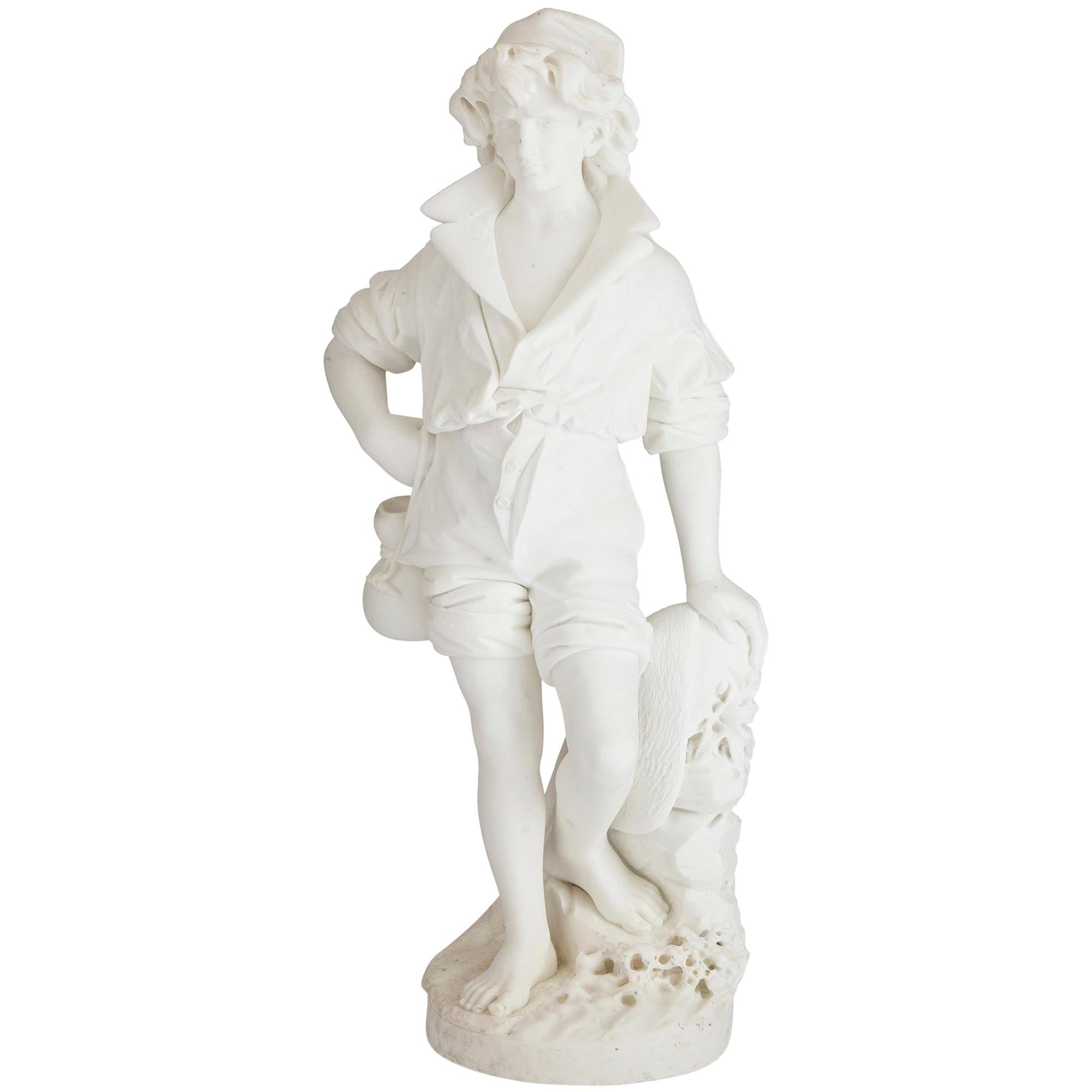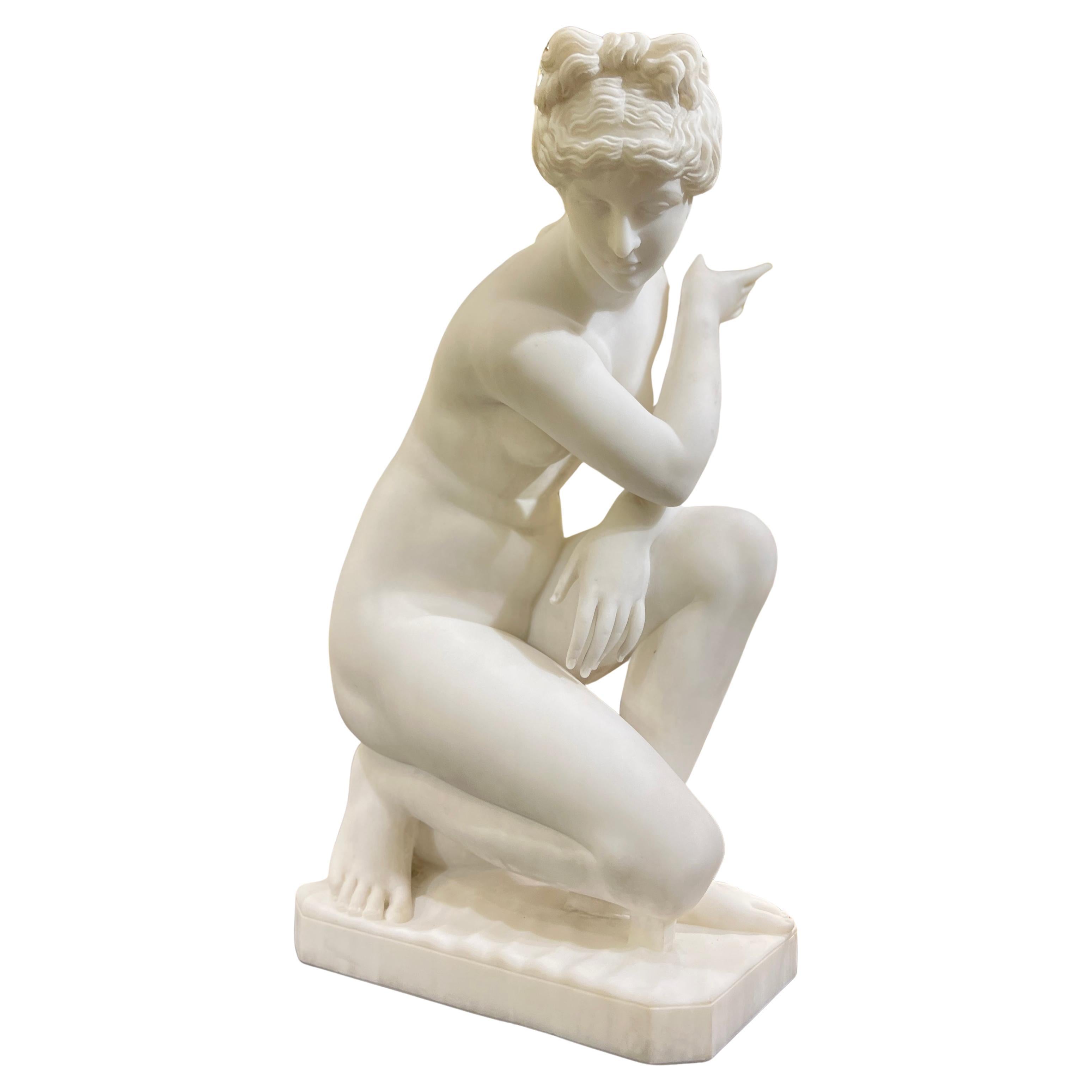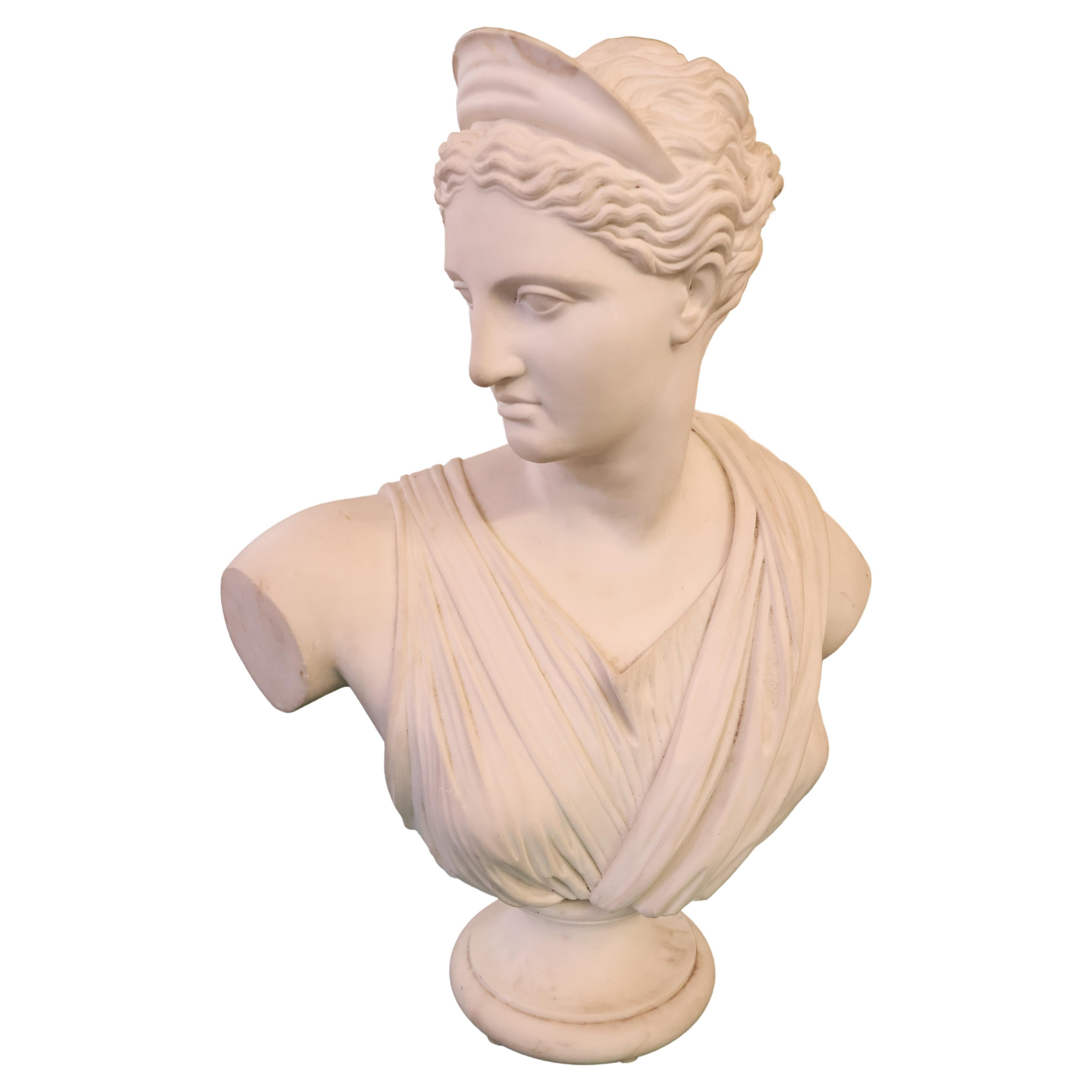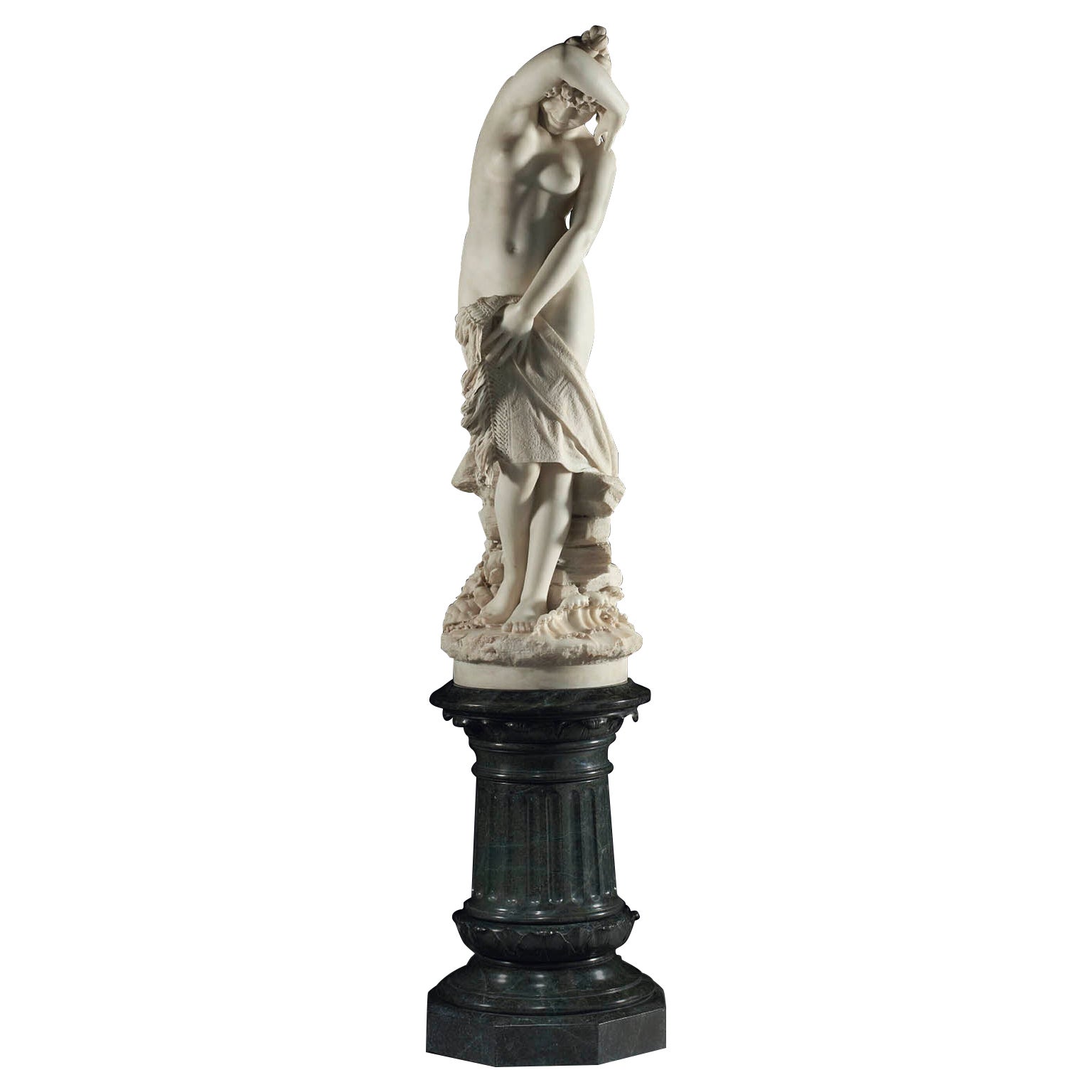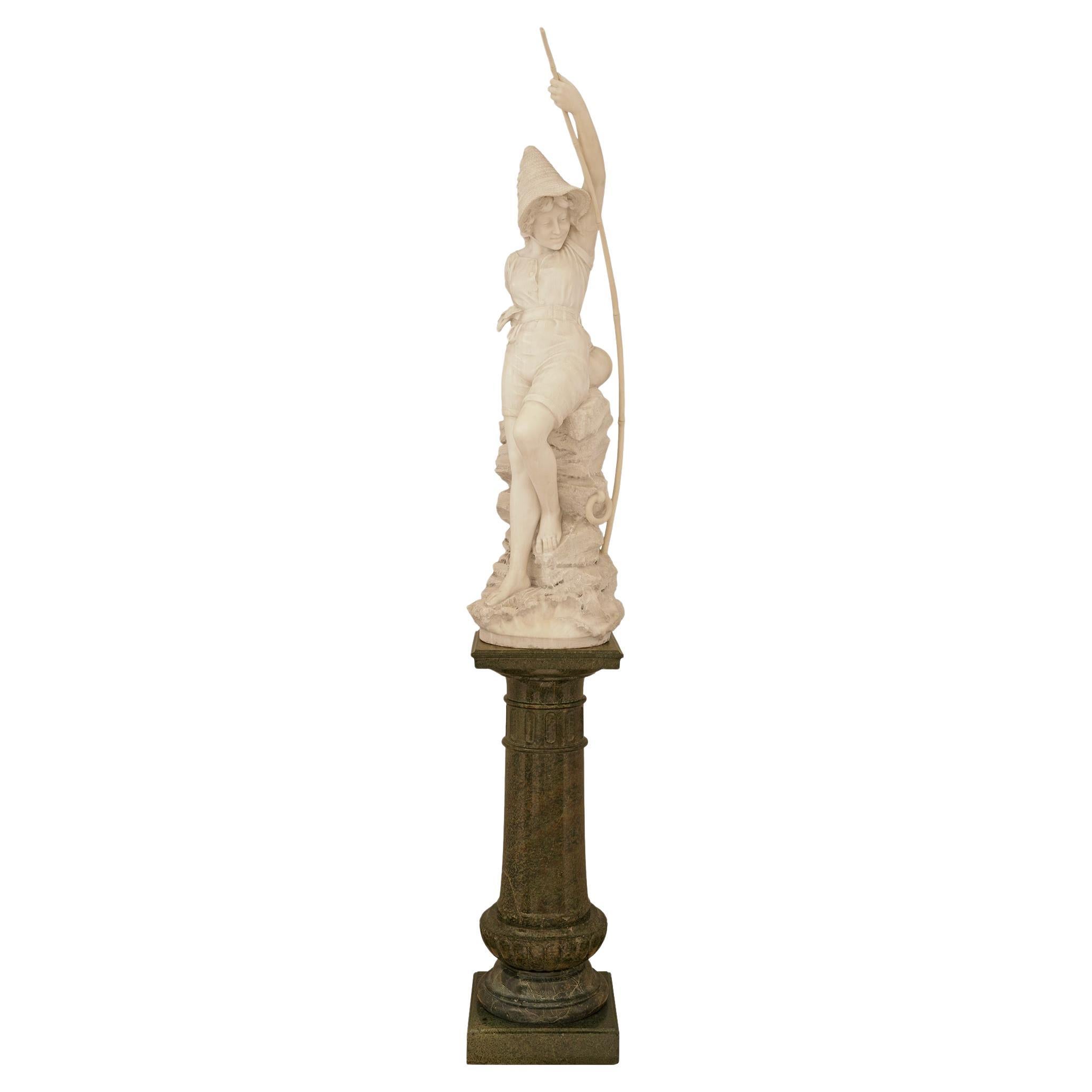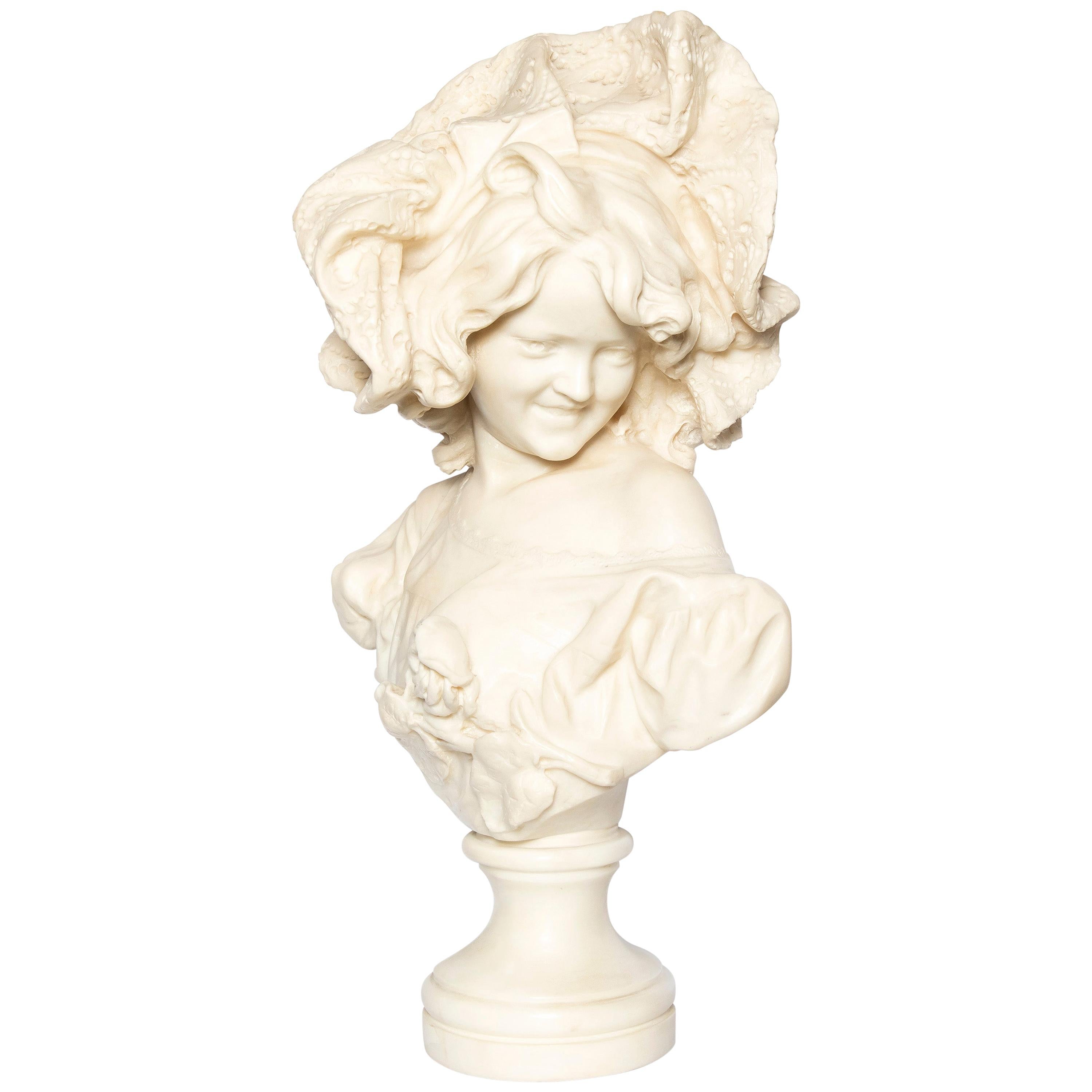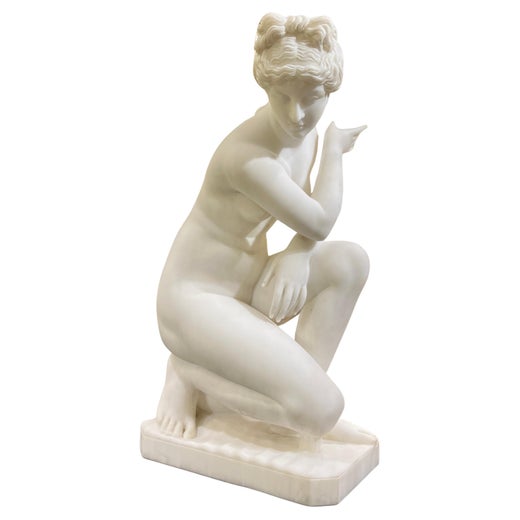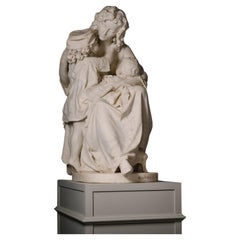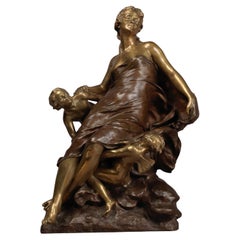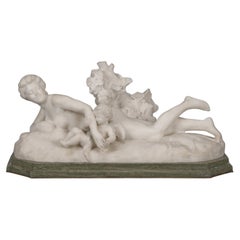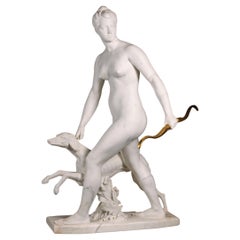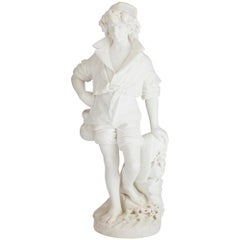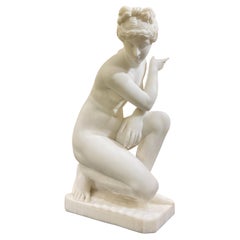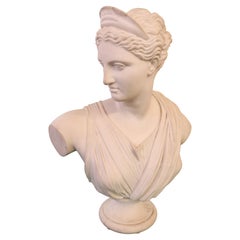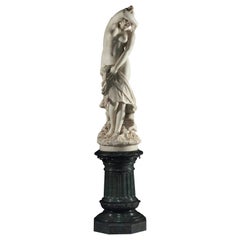Items Similar to ‘Mosè Salvato Dalle Acque’. An Important Marble Group By Pietro Bazzanti
Want more images or videos?
Request additional images or videos from the seller
1 of 8
‘Mosè Salvato Dalle Acque’. An Important Marble Group By Pietro Bazzanti
About the Item
Pietro Bazzanti (Italian, 1825-1895) - ‘Mosè Salvato Dalle Acque’.
An Important Exhibition Florentine Marble Group of Moses Rescued from the Waters, on a carved Rosso Levanto Pedestal.
Incised to the base ‘P. Bazzanti , Firenze’.
Exhibited Paris Exposition Universelle 1889.
Italy, Circa 1885.
Dimensions:
Total height 230 cm / 91 inches
Height figure 150 cm / 59 inches
Height of pedestal 80 cm / 32 inches
Maximum width of pedestal 66 cm / 26 inches.
This finely carved marble figural group epitomises the romantic historicist style that permeated Italian sculpture in the latter decades of the nineteenth century.
While the subject is drawn from religious history, the composition is infused with an emotional immediacy typical of nineteenth century genre sculpture, thereby distinguishing it within the broader context of sacred art of the period.
‘The Finding of Moses’, as recounted in the Book of Exodus, narrates the survival of the Hebrew infant following the Pharaoh’s decree that all male Israelite children be cast into the Nile.
Concealed by his mother and placed in a papyrus basket amongst the reeds, the infant Moses was discovered by Pharaoh's daughter who moved by compassion, resolved to preserve his life. At the suggestion of Moses’ sister, Miriam, who had discreetly observed the encounter, the princess entrusted the infant’s care to his biological mother, thereby ensuring his survival. As the child grew, he became the adoptive son of Pharaoh's daughter.
Pietro Bazzanti’s sculptural treatment of the subject captures the tender emotional bond forged at the moment of rescue. The child, trusting and curious, reaches out to touch the princesses’ necklace, while she smiles benevolently. Through this affectionate encounter, Bazzanti renders the biblical narrative accessible and resonant for the contemporary viewer. The princess is adorned with sumptuous drapery, elaborate jewellery, and a vulture headdress, an iconographic feature associated with royal women during the Old Kingdom, each detail painstakingly rendered in marble with remarkable textural sensitivity. The Nilotic environment is evoked through careful depiction of reeds entwining around the figure’s legs and the river’s flowing currents at her feet.
Pietro Bazzanti played a pivotal role in Florentine sculpture at the close of the 19th century. His studio, later known as the Galleria Bazzanti, was established in 1822 and continues to operate today. Specializing in sculpture inspired by antiquity and original allegorical and genre works, Bazzanti's studio attracted renowned sculptors like Cesare Lapini, Ferdinando Vichi, and Guglielmo Pugi, all contributing works bearing the studio's mark: "Galleria Bazzanti."
This present group is an autographed work by Pietro Bazzanti himself and exhibited at the 1889 Paris Exposition Universelle, where it can be seen in a stereoscopic view of the Italian section.
- Creator:Pietro Bazzanti (Sculptor)
- Dimensions:Height: 90.56 in (230 cm)Width: 22.84 in (58 cm)Depth: 25.6 in (65 cm)
- Materials and Techniques:
- Place of Origin:
- Period:
- Date of Manufacture:circa 1885
- Condition:Wear consistent with age and use.
- Seller Location:Brighton, GB
- Reference Number:Seller: B706401stDibs: LU1028015509322
Pietro Bazzanti
Pietro Bazzanti specialized in allegorical and genre subjects as well as copies of antique and Renaissance sculpture. Regarded as one of the most talented sculptors of his day, his studio in Florence became a center for other important sculptors such as Ferdinando Vichi, Cesare Lapini and Guglielmo Pugi. Many of these sculptors' works are inscribed Galleria Bazzanti.
About the Seller
5.0
Recognized Seller
These prestigious sellers are industry leaders and represent the highest echelon for item quality and design.
Platinum Seller
Premium sellers with a 4.7+ rating and 24-hour response times
Established in 1964
1stDibs seller since 2014
57 sales on 1stDibs
Typical response time: 2 hours
Associations
The British Antique Dealers' AssociationLAPADA - The Association of Arts & Antiques Dealers
- ShippingRetrieving quote...Shipping from: Brighton, United Kingdom
- Return Policy
Authenticity Guarantee
In the unlikely event there’s an issue with an item’s authenticity, contact us within 1 year for a full refund. DetailsMoney-Back Guarantee
If your item is not as described, is damaged in transit, or does not arrive, contact us within 7 days for a full refund. Details24-Hour Cancellation
You have a 24-hour grace period in which to reconsider your purchase, with no questions asked.Vetted Professional Sellers
Our world-class sellers must adhere to strict standards for service and quality, maintaining the integrity of our listings.Price-Match Guarantee
If you find that a seller listed the same item for a lower price elsewhere, we’ll match it.Trusted Global Delivery
Our best-in-class carrier network provides specialized shipping options worldwide, including custom delivery.More From This Seller
View AllAn Exhibition Lifesize Statuary Marble Figural Group
Located in Brighton, West Sussex
An Important Lifesize Statuary Marble Figural Group of a Mother and Her Two Children, Entitled 'Mamma ce n'è una sola' (You only have one mother), By Silverio Martinoli (Italain, 183...
Category
Antique 19th Century Italian Victorian Figurative Sculptures
Materials
Carrara Marble
'Cupid & Psyche' an Important Bronze Figure by François-Raoul Larche
By François-Raoul Larche
Located in Brighton, West Sussex
'Cupid & Psyche' - An important parcel-gilt and patinated bronze figure, by François-Raoul Larche.
Signed to the base 'Raoul Larche 1891'.
This finely cast parcel-gilt bronze figure depicts Cupid and Psyche with Zephyr.
François-Raoul Larche (1860-1912), the son of an ornamental sculptor, was a well-known Art Nouveau sculptor...
Category
Antique 19th Century French Figurative Sculptures
Materials
Bronze
A White Marble Figural Group of Venus and Cupid by Henri Weigele
Located in Brighton, West Sussex
A White Marble Figural Group of Venus and Cupid by Henri Weigele.
Signed ‘H. Weigele’ and titled ‘IL PASSEPA'
Born in Schierbach, Haut-Rhin, Henri Weigele (1858- 1927) studied sc...
Category
Antique 19th Century French Figurative Sculptures
Materials
Marble
‘Diana the Huntress’. A Near Lifesize Statuary Marble Group
By Alfred Boucher
Located in Brighton, West Sussex
Alfred Boucher (French, 1850-1934), ‘Diana the Huntress’, A Near Lifesize Statuary Marble Group.
Modelled nude with head turned looking to her left, striding forward holding the greyhound by its collar with her right hand and a giltwood bow in her left hand. On an integral carved base with foliage support.
Signed 'A. BOUCHER'
Boucher’s choice of pose is deliberately indebted to the celebrated mid-16th century painting of Diana the Huntress by an anonymous artist of the School of Fontainebleau. The painting is a mythical representation of Diane de Poitiers, the mistress of King Henry II, in the guise of the goddess Diana, who is shown nude, walking forward beside a greyhound, looking over her left shoulder and holding a bow. Another clear antecedent for Boucher’s ‘Diane the Huntress...
Category
Antique 19th Century French Neoclassical Revival Figurative Sculptures
Materials
Carrara Marble
'La Tuffolina', a Marble Group of a Diving Girl by Odoarda Tabacchi, circa 1880
By Odoardo Tabacchi
Located in Brighton, West Sussex
'La Tuffolina' - an important white marble group of a diving girl on a naturalistic base, by Odoarda Tabacchi
Italian, circa 1880.
Signed 'O.Tabacchi/Torino'.
This Fine marble group depicts a graceful young girl wearing a knitted bathing dress, her hair held in a chignon with her arms raised above her head in a diving position, standing on the edge of a natural POOL, with the waves lapping behind her.
This charming and dynamic figure, full of natural grace proved to be one of Tabacchi's most popular sculptures and was edited in a number of sizes in both bronze and marble.
First exhibited in marble at the Esposizione d'arte di Napoli del 1877, it was reportedly purchased by King Vittorio Emanuele II and illustrated in L'Illustrazione Italiana, No 23, June 10, 1877, in an engraving based on a sketch by Michetti.
It was subsequently exhibited with great acclaim at the 1878 Paris Exposition Universelle and examples were also produced in ceramic, including Parian ware examples by the English firm of Robinson & Leadbenton.
A comparative marble version is in the collection of the Museo di Capodimonte, Naples.
Odoardo Tabacchi...
Category
Antique Late 19th Century Italian Art Nouveau Figurative Sculptures
Materials
Marble
‘Gloria Victis’, A Patinated Bronze Figural Group by Mercié, Cast by Barbedienne
By Ferdinand Barbedienne
Located in Brighton, West Sussex
A Patinated Bronze Figural Group of ‘Gloria Victis’ (‘Glory to the Vanquished’), Cast by Ferdinand Barbedienne from the Model by Marius-Jean-Antonin Mercié (French, 1845-1916).
‘Gloria Victis’ (‘Glory to the Vanquished’).
Bronze, gilt and dark brown patina.
Signed 'A. Mercié', with foundry inscription 'F. BARBEDIENNE, Fondeur. Paris.' and A. Collas reduction cachet. The integral base titled 'GLORIA VICTIS'.
This cast is part of a limited edition by the Barbedienne Foundry.
France. Circa 1880.
‘Gloria Victis’ is one of the most recognisable and important works of sculpture of the nineteenth century and a definitive image of France’s historic national identity. The figure of glory, winged and wearing armour, carries a dying young warrior heavenwards towards fame and immortality. The compositional daring of the group must be admired for balancing two figures on the minimal support of one foot, wings spread in the moment before taking flight.
Mercié was a student at the French Academy of Rome when the Prussians invaded France in 1870. Shortly after the war had begun, he executed a group depicting the figure of Fame supporting a victorious soldier. When news reached Mercié in Rome that the French had surrendered, he decided to alter his group, replacing the victorious soldier with a defeated casualty, thus transforming an allegory of ‘Glory to the Victors’ into one of ‘Glory to the Vanquished’. Completed in 1872, a year after the defeat of French soldiers against the Prussian army, the statue personifies a defeated but heroic France. The title is also a reversal of the famous formula, ‘Vae Victis’ (Death to the Vanquished), which the Gallic general Brennus exclaimed upon defeating the Romans in 390 BC. The figure of the fallen soldier was thought to represent Henri Regnault, a fellow sculptor of Mercié who was killed on the last day of fighting.
Measuring 317 cm. high the original group of ‘Gloria Victis’ was unveiled in plaster at the Salon of 1872. It was bought by the City of Paris for the sum of twelve thousand francs and then cast in bronze by Victor Thiébaut for eight thousand five hundred francs. The bronze was exhibited at the Salon in 1875 and first placed in Montholon Square in the 8th arrondissement. In 1884 it was transferred to the courtyard of the Hôtel de Ville and in 1930, it entered the collection of the Musée du Petit Palais, where it can be seen to this day.
The Thiébaut Frères foundry also cast Gloria Victis bronzes for the cities of Niort (requested 1881) Bordeaux (requested 1883), Châlons-sur-Marne (today, Châlons-en-Champagne; requested 1890), and Cholet (requested 1901). In 1905, the Danish brewer and art collector Carl Jacobsen was permitted to have an exact cast made of the original sculpture in Paris, on condition that the base was made 2 cm lower and bore the inscription “Original tilhører Paris By” (The original belongs to the City of Paris). It too was cast by the Thiébaut Frères foundry. Gloria Victis was one of Jacobsen’s most important and his last acquisition. Today it has been returned to its original position in the Winter Garden at Glyptoteket, Copenhagen, Denmark.
The full-size plaster was shown again at the Paris Expositon universelle of 1878 alongside a bronze reduction by Barbedienne. By this time Antonin Mercié had entered into a commercial edition contract with the Ferdinand Babedienne foundry to produce bronze reductions of Gloria Victis, his most famous work. Gloria Victis is first recorded to have been produced in three sizes and by 1886 Barbedienne’s ‘Catalogue des Bronzes D’Art’ lists six sizes measuring 3/5, 9/20, 7/20, 3/10, 6/25 and 2/10, of the original. These reductions were produced by an invention of Barbedienne’s business partner Achille Collas. The Collas reducing machine was a type of complex mechanical pantograph lathe that enabled sculpture to be mathematically measured and transcribed to scale, in the round, thus making a reduced size plaster from which a bronze could be cast.
Mercié's modern sculpture had become an instant classic, even receiving an entry in the Nouveau Larousse Illustré. The success of the group undoubtedly lay in the fact that it was admired not just on an aesthetic level, but also on a patriotic level, particularly in its commemoration of heroism in defeat. Immediately ‘Gloria Victis’ was recognised as a national artwork, capable of arousing patriotism and casts were ordered from Barbedienne as local memorials commemorating the war’s dead for cities across France. ‘Gloria Victis’ was considered so much a part of France’s national identity that for the 1900 Paris Exhibition, Ferdinand Barbedienne’s nephew Gustave Leblanc, loaned a bronze example to feature as part of l’Exposition centennale de l’art français.
Literature:
For an interesting account of the process of creating a reduction in bronze of the Gloria Victis by Barbedienne and illustrations of the casting and finishing of the bronze see:
'Ferdinand Barbedienne': Theodore Child; Harper's new monthly magazine, Volume 73, Issue 436, September 1886.
‘Contemporary French Sculptors’: The Century, Volume 33, Issue 3, Jan 1887.
‘Modern French Sculpture’: Harper's new monthly magazine, Volume 76, Issue 452,
January 1888.
S, Lami, ‘Dictionnaire des sculpteurs de l'Ecole française au dix-neuvième siècle’, Tome III. G.-M., Paris, 1914, p. 432.
Peter Fusco and H.W. Janson, The Romantics to Rodin: French Nineteenth Century Sculpture from North...
Category
Antique 19th Century French Figurative Sculptures
Materials
Bronze
You May Also Like
Large Italian Marble Sculpture by Pietro Bazzanti
By Pietro Bazzanti
Located in London, GB
Large Italian marble sculpture by Pietro Bazzanti
Italian, late 19th century
Measures: Height 105cm, width 45cm, depth 40cm
The present sculpture, carved from brilliant white marble, depicts a young boy standing...
Category
Antique Late 19th Century Italian Neoclassical Figurative Sculptures
Materials
Marble
Crouching Venus Italian White Marble Sculpture by Pietro Bazzanti
By Pietro Bazzanti
Located in New York, NY
Italian white marble sculpture of the crouching Venus after the ancient Greek Hellenist period work, finely carved by the Italian master, Pietro Bazzanti. Signed P Bazzanti Florence.
Category
Antique Late 19th Century Italian Neoclassical Figurative Sculptures
Materials
Carrara Marble
Pietro Bazzanti 19th Century Italian Carrara Marble Bust of Roman Woman
By Pietro Bazzanti
Located in Long Branch, NJ
Pietro Bazzanti 19th Century Italian Carrara Marble Bust of Roman Woman
Dimensions : 31" Tall X 24" Wide X 10" Deep
This gorgeous marble bust was made by Pietro Bazzanti (1842-1881...
Category
Antique Late 19th Century Italian Classical Roman Busts
Materials
Carrara Marble
Pietro Bazzanti, Italian 19th Carved Marble Figure Semi-Nude Young Bather Girl
By Pietro Bazzanti
Located in Los Angeles, CA
Pietro Bazzanti - Barzanti (Italian, 1825-1895) "After the Bath" - a very Fine and large carved white Carrara marble figure of a semi-nude young maiden standing by the sea-shore. The smiling and posing young beauty, with bare breasts and back, her right arm juxtaposed over her head, while holding a blanket over her waist with her left hand and standing barefoot by a rocky seawall and wavy shoreline. Signed 'P. Barzanti/Florence' (on reverse) and raised on a cylindrical swiveling carved verde antico solid marble pedestal. circa: Florence, 1880-1890.
Pietro Bazzanti or Barzanti (Italian, 1825-1895) was a 19th Century Italian sculptor born in Florence. Together with his brother, Niccolò Bazzanti (Firenze, 1802-1869) who was also a sculptor, they both worked the sprawling Florentine studio 'Pietro Bazzanti e Figlio' a hugely successful sculpture studio, operated within the family at their gallery on Lungarno Corsini until the mid-twentieth century. The studio was a place where many talented professors and apprentice sculptors specialized in sculpting marble...
Category
Antique Late 19th Century Italian Greco Roman Figurative Sculptures
Materials
Marble, Carrara Marble
$198,750 Sale Price
27% Off
Italian 19th century Carrara statue of a fisher maiden, by Pietro Bazzanti
By Pietro Bazzanti
Located in West Palm Beach, FL
A sensational and extremely well executed Italian mid 19th century white Carrara and Vert de Patricia marble statue of a young Neapolitan fisher maiden, signed by Pietro Bazzanti. This stunning statue is raised by a Vert de Patricia marble pedestal with a round socle on a square base supporting the column decorated with a gadrooned band at the bottom and a fluted band at the top. The statue is of a young Neapolitan fisher maiden is standing on a rocky outcrop, battered by waves lapping at her feet. She leans on a fishing pole held in one hand, while steadying herself with the other hand as she looks down into the water. She is wearing a short-sleeved striped frock with a fabric sash fashioned as a belt upon which is fastened a gourd at the back and a handkerchief tucked in at the front. She wears a lovely conical straw hat with flowers...
Category
Antique 19th Century Italian Figurative Sculptures
Materials
Marble, Carrara Marble
Carrara Marble Bust Signed P. Bazzanti, Italy, Florence, Late 19th Century
By Pietro Bazzanti
Located in Buenos Aires, Buenos Aires
Carrara marble bust signed P. Bazzanti. Italy, Florence, late 19th century.
Category
Antique Late 19th Century Italian Belle Époque Busts
Materials
Carrara Marble
Recently Viewed
View AllMore Ways To Browse
Egyptian Goddess
Renaissance Style Table Black
Italian Rosso Levanto
Rosso Levanto Table
32 Pedestal Table
Grand Tour Marble Table
Antique Rosso Marble
Italian Renaissance Pedestal Table
Egyptian Grand Tour
Renaissance Centre Table
Moses Carved
Cesare P
Lapini Marble
Rosso Levanto Marble Pedestal
Pugi Marble Sculpture
Moses Marble
Art Deco Goldscheider Figurines
Maling Pottery
